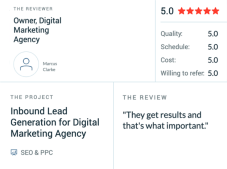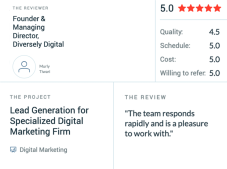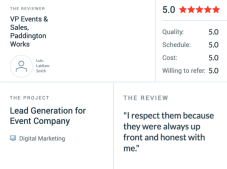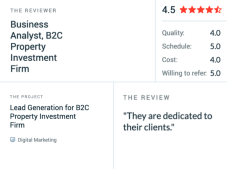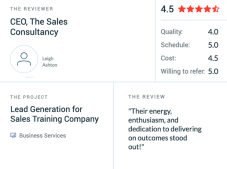How To Create An Email Marketing Campaign That Converts Leads To Sales
Email marketing campaigns are an excellent way to generate leads and convert them into sales. However, creating a successful email campaign can be challenging if you don’t have the right tools and strategies.
In this article, we’ll share tips on creating an email marketing campaign that converts leads into sales.
Email Marketing Campaign Types
With so many different types of email campaigns available, it can be hard to know where to start. Below are some of the most common types of email marketing campaigns and what they’re used for.
Promotional Email Marketing Campaigns
First up is the promotional campaign. This type of email is designed to promote a specific product or service. The whole point is to encourage recipients to purchase. Promotional emails often include discounts or special offers as an incentive to buy and can be sent out regularly to keep customers engaged.
Newsletter Email Marketing Campaigns
Another popular type of email campaign is the newsletter. Newsletters are typically sent out regularly (weekly, monthly, etc.) and provide subscribers with updates on industry news, company events, new products or services, and other relevant information.
Onboarding Email Marketing Campaigns
Onboarding email marketing campaigns are a vital part of any business’s customer acquisition strategy. They are the initial communication sent to new customers, welcoming them into the brand’s world and setting the tone for future interactions. A well-crafted onboarding campaign can increase customer retention rates, reduce churn, and drive revenue growth.
Re-engagement Email Marketing Campaigns
Re-engagement email campaigns are a powerful tool for businesses to reconnect with their inactive subscribers. These campaigns target individuals who have not engaged with your brand or opened your emails in a certain period. By sending targeted and personalised messages, businesses can reignite interest in their products or services and boost customer loyalty.
Step-By-Step Guide To Creating An Email Marketing Campaign
Creating an email marketing campaign can be daunting, especially if you’re new to digital marketing. But don’t worry! This step-by-step guide teaches you how to create an email marketing campaign that engages your target audience and drives conversions.
Know Your Goals
Without a clear goal, you can’t measure the success of your email campaign. Setting specific goals will help you understand how well your emails are performing and identify areas for improvement. For instance, if your goal is to increase sales through email marketing, then tracking the conversion rate of each email campaign can help you see whether that objective has been met.
Understand Email Types
Businesses can promote their products or services and reach their target audience through email marketing. However, not all emails are created equal, and understanding the different types of emails can help you create an effective email marketing campaign.
Businesses can use several types of emails to communicate with their subscribers; we have outlined some of the above.
Know Your Audience
Understanding who your target audience is and what they want will help you tailor your message and increase the chances of engagement. The more personalised and relevant your emails are, the better your chance of converting them into customers.
It’s important to define your target audience. This can be done through demographic research or analysing customer data. Once you’ve identified who they are, take the time to understand their needs and interests. What motivates them? What challenges do they face? By understanding these factors, you can craft messaging that resonates with them on a deeper level.
Plan Emails And Follow-Ups
Planning emails and follow-ups can help you create a more effective email campaign that resonates with your target audience. The first step in creating an email campaign is to plan the content of each email.
You must decide what message to convey in each email, whether promoting a new product or service or sharing valuable information with your audience. You should also consider the timing of each email and how frequently you will send them out.
After planning the content of each email, it’s important to plan for follow-ups as well. Follow-up emails are crucial for maintaining engagement with your subscribers and encouraging them to take action.
Craft Your Subject Line
Crafting a subject line for your email marketing campaign is the next step towards engaging your audience. It is imperative to create a subject line that catches the attention of your targeted subscribers and entices them to open your emails. A well-crafted subject line can increase the open rate of your emails, while a poorly crafted one can lead to lower engagement rates.
When creating a subject line, it is important to remember that it should be short and sweet. Aim for no more than 50 characters, as most email clients cut off longer subject lines. You should also ensure that the subject line accurately reflects what’s inside the email – misleading titles may get more opens initially. Still, they’ll ultimately hurt your brand’s reputation and lead to unsubscriptions.
Focus On Email Marketing Design
Design elements can make or break the success of your campaign by attracting or repelling potential customers. To create an effective email marketing campaign, it’s crucial to focus on email marketing design.
First and foremost, consider the layout of your emails. Remember that most people view emails on their mobile devices, so make sure your emails are responsive and easy to read on smaller screens. Use a simple and clean layout with plenty of white space to avoid overwhelming readers with too much information at once.
Next, pay attention to branding. Your emails should reflect your company’s overall branding strategy using consistent colours, fonts, logos and imagery throughout all communications. This will help increase brand recognition and build trust with customers over time.
Finally, don’t forget about calls to action (CTAs).
Test And Track The Results
To achieve optimal results, it is important to test and track the performance of your emails. Testing your emails before sending them out allows you to identify potential issues preventing your subscribers from opening or engaging with your content. By testing variables such as subject lines, email design, and call-to-action buttons, you can determine what works best for your audience and adjust accordingly.
Tracking the results of your email campaigns enables you to analyse how each email performed in terms of open rates, click-through rates, conversions, and other metrics. This information will help you make data-driven decisions on refining future campaigns for even better results.
Conclusion
Creating an effective email marketing campaign takes more than just hitting the send button.
Firstly, identify your target audience and create an email list. This can be done by collecting emails from website visitors or incentivising people to sign up for your newsletter.
Craft compelling subject lines and content that will grab your readers’ attention. Remember that people receive countless emails daily, so making yours stand out is important.
Lastly, test and analyse your campaign’s performance regularly.
Was this article helpful? Let us know in the comments.
FAQ
What is the simplest email program?
One such program is Gmail. It has a clean interface that makes it easy to navigate, even for beginners. With features like spam filters and automatic categorisation of emails into primary, social, and promotions tabs, you can stay organised without much effort.
How long does it take to create an email marketing campaign?
There is no definitive answer since the timeline varies depending on certain factors such as your goals, budget, target audience and industry.
How long should an email marketing campaign last?
The answer may vary depending on the nature of your business and the goals you want to achieve through email marketing. The duration of an email campaign can range from a single newsletter or promotional message to a series of emails spread over several weeks or months.







